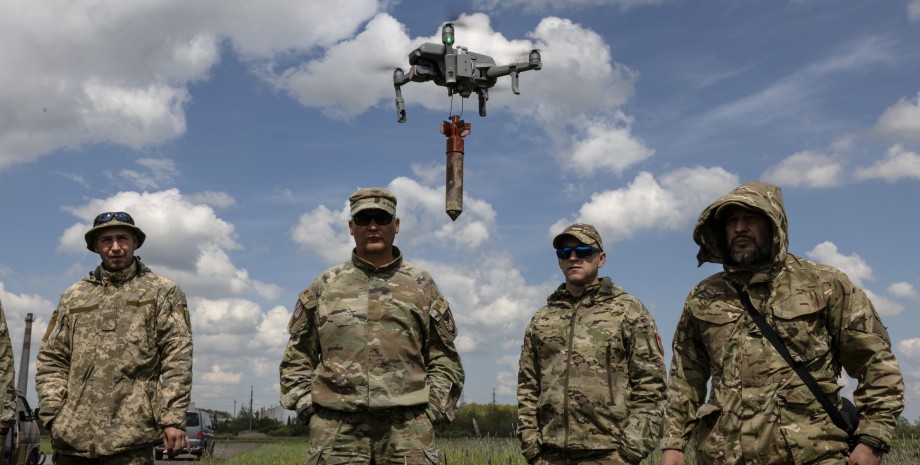
The hopes for the help of the European Union, who promised to produce a million ammunition, were not justified. The event itself feels a lack of production capacity. Since the beginning of the Great War, the United States has sent more than 2 million 155 mm caliber shells to Ukraine, but because of a shortage of warehouses, cassette ammunition began to be issued. Russia, meanwhile, increases the production of ammunition: builds new factories and adjusts supplies from Iran and North Korea.
Military production in the Russian Federation was distributed between state factories, public-private partnerships and civilian enterprises of dual-use. Kiev found its way out in the current situation: to compensate for the deficiency of artillery shells with drones. Deputy Minister of Defense Ivan Havrylyuk still acknowledges that such an idea will not solve the problem of ammunition deficiency.
The official promises to establish the production of shells "almost all nomenclatures of the former USSR" and a 155 mm caliber together with Western companies. "It is expected that next year the Ukrainian defense industry will produce enough shells to cover the difference between what is needed on the forefront and what partners can give," he said in an interview with the Air Force.
The joint production of ammunition in Ukraine was discussed in negotiations with US companies during the December visit of President of Ukraine Vladimir Zelensky to the United States. In 2024, Kyiv hopes with American partners to make missiles for the S-300 and Beech SPRs, Gavriluk said. Unmanned devices perfectly complement the work of artillery, but do not replace it. The first factor is the weather conditions: drones cannot fly during rainfall and if strong wind blows.
The second problem is the Russian RUB stations and antironous rifles with a wide range of opportunities, explains the focus military expert Pavlo Narozhny. In addition, drones have extremely low explosive capacity, its weight reaches 3 kilograms. At the same time, a 155 mm western shell weighs 47 kilograms and carries 15 kilograms of explosives - five more. "Artillery shoots not bolvanes that fall into the ground.
The projectile body during the explosion flies into many metal fragments up to 1 mm in size with a striking effect of up to 500 meters. These fragments are stitched the enemy, "the people's people explains. The ratio of the efficiency of drones and ammunition to artillery in various combat operations reaches 1:15. When the distance is over 30 kilometers, you can only work with artillery.
If the howitzer is able to cover the front area with a radius of 15 kilometers, turn around and beat in groups of the enemy at a speed of up to 4 shots in 30 seconds, then the FPV-Dron will not do so. "The gun works for one goal, turns and shoots in other groups. How does the drone FPV work? The operator leads it to a target for up to 20 minutes, all this time he manages only one UAV, which may not get into the target, or he will be put settings of EWS ", - the expert says.
The percussion drone is more suitable for achieving targets after the artillery arrives. If the tank has been damaged from the ammunition explosion but did not fire, it can be hit by a drone and then the effect will be better. It is impossible to compare the military resources of Russia and Ukraine, because the first has a powerful defense-industrial complex and advantage in human resources, emphasizes Deputy Minister of Defense Ivan Havrylyuk.
Russia has long accumulated UAVs, in particular, massively importing Iranian drones-Kamikadze Shahd. The most important indicator of shock drones in the occupiers is the intensity of strikes in Ukraine. On November 25, the Armed Forces of the Russian Federation launched 75 shock drones "Shahd", which became a record number during the Great War. In addition, the Armed Forces of the Russian Federation has a whole spectrum of bargage ammunition type "Lancet".
The lesion of the target by one drone is a heavy load on its operator. In one battle day, the operator successfully launches a maximum of five drones, and a group of calculation of artillery of three people strikes the goals of the enemy without restrictions, adds Director of the Information and Consulting Company Defense Express Sergey Zgurets. Another issue concerns the required number of ammunition 155 mm.
The Estonian Ministry of Defense previously published a report called "Military Strategy for Victory of Ukraine and the Defeat of Russia", which states that the Armed Forces requires at least 200 thousand shells a month to keep the local fire advantage over the Armed Forces of the Russian Federation. But then the reserves of the European Union and the US will completely empty in 2024. "If we see such figures for ammunition, drones should be at least within the same extent.
Due to the fact that their break power and flight range are less, we have to calculate additional costs accordingly," Zgurets emphasized. The Estonian Ministry of Defense also notes that in 2023 production in the Russian Federation and the renewal of projectile reserves thanks to countries such as North Korea has tripled, reaching 3. 5 million. Next year, the figure can reach 4. 5 million.










All rights reserved IN-Ukraine.info - 2022